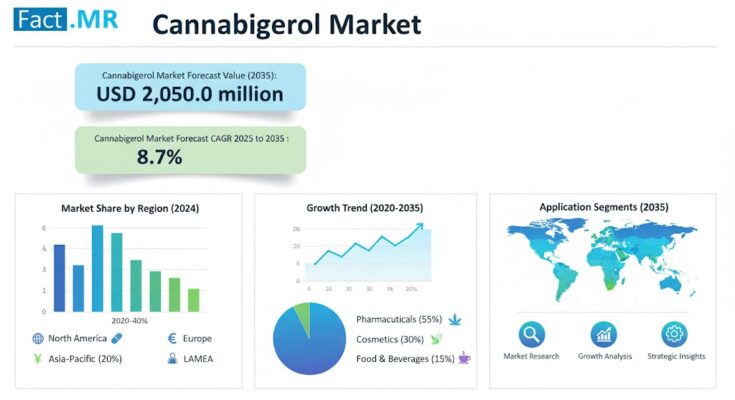The global cannabigerol market is on a remarkable growth trajectory, propelled by the expanding applications of cannabinoids in pharmaceuticals, nutraceuticals, cosmetics, and wellness products. According to a recent report by Fact.MR, the market is projected to grow from USD 890.0 million in 2025 to approximately USD 2,050.0 million by 2035, marking an absolute increase of USD 1,160.0 million. This reflects a total growth of 130.3%, with the market forecast to expand at a CAGR of 8.7% between 2025 and 2035.
As consumer awareness about the therapeutic potential of CBG rises—particularly in anti-inflammatory, neuroprotective, and mood-enhancing applications—the compound is emerging as one of the most promising non-psychoactive cannabinoids in the cannabis industry.
Strategic Market Drivers
- Pharmaceutical Innovation and Clinical Research
Growing research into CBG’s pharmacological properties is significantly shaping market expansion. Clinical studies suggest that cannabigerol may help manage conditions such as glaucoma, inflammatory bowel disease (IBD), Huntington’s disease, and bacterial infections. Pharmaceutical companies are increasingly investing in cannabinoid-based therapeutics, driving demand for high-purity, consistent CBG formulations that meet regulatory standards.
- Expanding Wellness and Nutraceutical Demand
The surge in consumer interest in plant-based and functional wellness products has opened new avenues for CBG. It is being incorporated into dietary supplements, beverages, and skincare formulations aimed at stress relief, focus enhancement, and skin health. The “clean-label” movement and growing preference for non-psychoactive cannabinoids further support CBG’s integration into mainstream health and wellness portfolios.
- Growth of the Cosmetic and Personal Care Segment
CBG’s antioxidant and antibacterial properties make it a highly desirable ingredient in personal care products. Cosmetic manufacturers are leveraging CBG in formulations targeting acne, aging, and skin inflammation. This trend aligns with the global shift toward natural and sustainable cosmetic ingredients.
- Regulatory Developments and Legalization Trends
The gradual legalization of hemp-derived cannabinoids across North America, Europe, and parts of Asia-Pacific is unlocking new opportunities for CBG producers. Favorable government policies, research approvals, and improved clarity on THC limits are accelerating commercialization and cross-border trade.
Browse Full Report: https://www.factmr.com/report/cannabigerol-market
Regional Growth Highlights
North America: Leading Through Research and Commercialization
The United States remains at the forefront of the CBG market, supported by progressive hemp regulations and strong investment in cannabinoid R&D. Canada follows closely, benefiting from a robust legal framework for cannabis-derived products. North America is expected to account for a substantial share of global revenues by 2035, driven by partnerships between biotech firms, extractors, and pharmaceutical companies.
Europe: Expanding Medical and Nutraceutical Applications
Europe’s market growth is primarily driven by the U.K., Germany, and Switzerland, where cannabinoid-based therapies and supplements are gaining regulatory acceptance. Stringent quality and safety standards in the EU are encouraging producers to adopt advanced extraction technologies and standardized production processes to ensure purity and efficacy.
Asia Pacific: Emerging Potential with Evolving Legal Frameworks
Countries like Japan, Australia, and South Korea are showing early interest in non-psychoactive cannabinoids for health and beauty products. With growing consumer acceptance and government-led pilot programs, the region is likely to emerge as a high-growth market over the next decade.
Latin America and Middle East & Africa: Nascent but Growing Markets
The increasing legalization of hemp cultivation and expanding wellness markets in Latin America are fostering regional production. Meanwhile, the Middle East and Africa are witnessing gradual acceptance, supported by public health initiatives and private sector investments in cannabis research.
Market Segmentation Insights
By Source:
- Hemp-derived CBG – Dominating global production due to high legality and scalability.
- Cannabis-derived CBG – Gaining traction in medical-grade applications.
By Application:
- Pharmaceuticals: Drug development for inflammatory and neurological disorders.
- Nutraceuticals: Dietary supplements and wellness formulations.
- Cosmetics: Skin repair, anti-aging, and antioxidant products.
- Food & Beverages: Functional and infused food products.
By Distribution Channel:
- B2B Sales: Partnerships between cannabinoid producers, cosmetic brands, and pharma firms.
- B2C Sales: Direct-to-consumer online platforms and retail expansion in legalized regions.
Challenges and Market Considerations
- Regulatory Complexity: Varied global policies on cannabinoids hinder uniform commercialization.
- High Production Costs: Extraction and purification processes for CBG remain capital-intensive.
- Supply Chain Constraints: Limited hemp biomass supply and strain availability challenge scalability.
- Need for Clinical Validation: Widespread adoption requires more clinical evidence supporting efficacy and safety.
Competitive Landscape
The global cannabigerol market is characterized by innovation, vertical integration, and collaboration between biotechnology and pharmaceutical firms. Key players are investing in precision extraction technologies, genetics optimization, and formulation development to meet the rising demand for high-purity CBG.
Key Companies in the Cannabigerol Market:
- EcoGen Biosciences, Inc.
- GenCanna Global, Inc.
- KND Labs
- Mile High Labs, Inc.
- Cannabinoid Creations, LLC
- Folium Biosciences, Inc.
- Creo Bioscience
- Open Book Extracts, LLC
- Front Range Biosciences, Inc.
- Medical Marijuana, Inc.
These companies are focusing on expanding their production capacity, strengthening research partnerships, and developing standardized formulations for pharmaceutical and wellness markets.
Recent Developments
- June 2024 – Creo Bioscience expanded its synthetic cannabinoid production capabilities, aiming to produce CBG at pharmaceutical-grade purity using fermentation technology.
- April 2024 – Open Book Extracts, LLC launched a new line of water-soluble CBG formulations for nutraceutical and beverage applications.
- January 2024 – Front Range Biosciences announced breakthroughs in high-CBG hemp genetics, increasing yield efficiency by over 25%.
Future Outlook: Toward Precision Cannabinoid Innovation
The next decade is poised to bring a transformation in the cannabigerol industry, driven by precision biomanufacturing, sustainability, and clinical validation. Companies integrating AI-driven extraction control, biotech strain development, and eco-friendly cultivation will gain a strategic edge.
As global consumer acceptance of cannabinoids broadens and regulations mature, CBG is expected to become a cornerstone ingredient in the future of healthcare, nutrition, and personal wellness—delivering safe, effective, and sustainable cannabinoid-based solutions for a healthier world.



